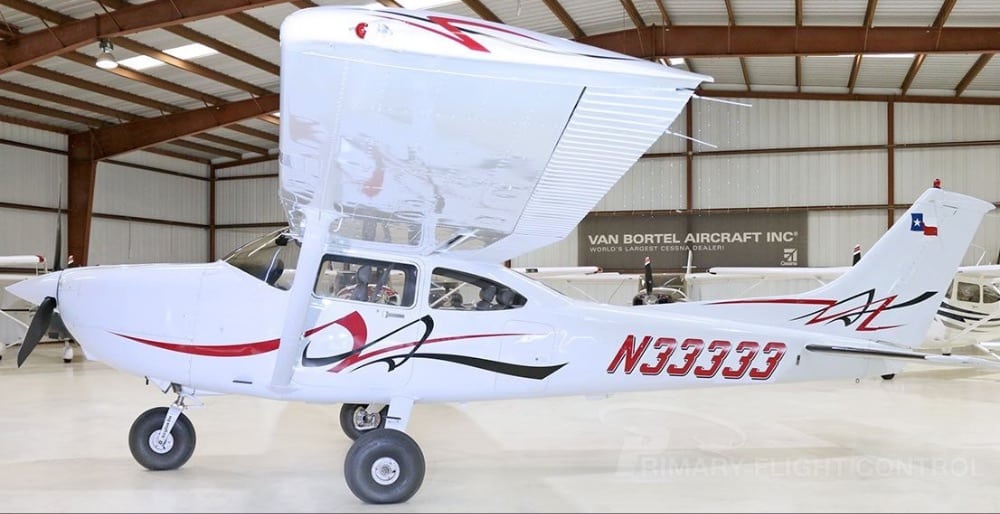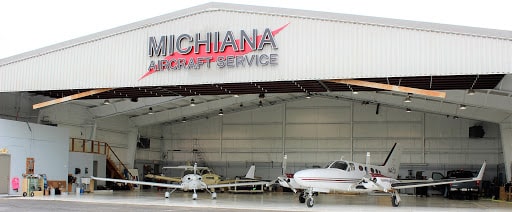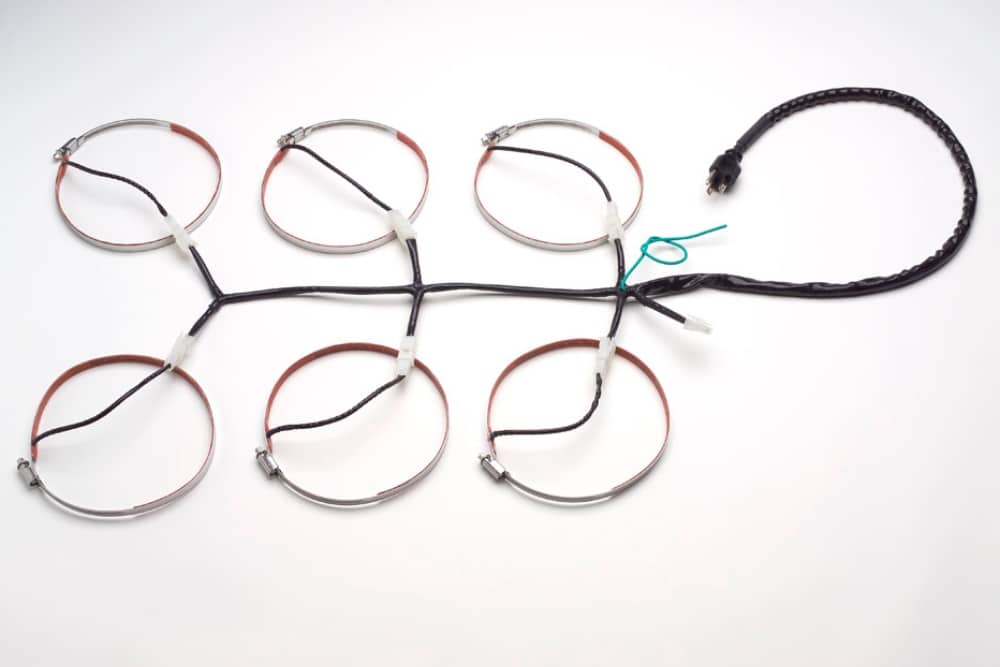
Will decided it was time to buy an airplane. A first-time buyer who lives a stone’s throw northwest of Chicago, he reached out to Savvy Aviation last March indicating that he’d found a 1998 Cessna 182S Skylane advertised online that caught his interest. This plane was equipped with vortex generators and oversized high-floatation tires optimized for back-country operations, which suited Will’s intended mission profile to a tee. The plane was being brokered by Van Bortel Aircraft, Inc. (“The World’s Largest Cessna Dealer”) and was hangared at their facility in Arlington, Texas (midway between Dallas and Ft. Worth).
Will obtained the airplane’s scanned maintenance records in PDF format and uploaded them to Savvy for a preliminary logbook review—something Savvy is happy to do at no charge because we want to make sure the aircraft’s records contain no red flags or show-stoppers before our clients make an offer on the aircraft or spend money performing a prebuy examination. Often, a buyer will have identified two or three candidate aircraft of interest and will ask Savvy to do a logbook review for each of them and recommend which one we feel is the most attractive purchase candidate. We’re happy to do that at no charge, too.
In this case, however, Will had just one airplane in his sights, and he’d already enrolled online for a paid Savvy-managed prebuy. The task of reviewing the logbooks fell to Tony Barrell A&P/IA, one of Savvy’s most experienced account managers with more than 30 years experience working on general aviation airplanes, half of that as Director of Maintenance of the busy maintenance facility operated by Ohio State University in Columbus.
Sequence of Events
“I see you went ahead and signed up for SavvyPrebuy already,” Tony told Will. “This puts the cart a little ahead of the horse, but I will review the log books shortly and then hopefully we can get things rolling on your prebuy. Have you made an offer on this aircraft yet? Has the seller accepted it? Do you have a purchase/sale agreement signed?”
“No, an offer has not yet been made,” replied Will. “They are asking $279,500.”
It was apparent that Will, as a first-time buyer, was a bit fuzzy on the sequence of events when buying an airplane. It usually goes something like this:
- Buyer identifies a purchase candidate
- Buyer reviews logbook and other available information
- Buyer makes an offer Seller accepts offer (or makes a counter-offer)
- Buyer and seller agree on a price (conditional on prebuy findings)
- Buyer and seller sign a conditional purchase/sale agreement
- Buyer arranges to have a prebuy performed
- Depending on the prebuy findings, buyer decides to (1) buy the aircraft at the agreed-to price, (2) reject the aircraft and walk away, or (3) buy the aircraft at a renegotiated price
About an hour later, Tony got back to Will: “Savvy has reviewed the logbook entries for the 1998 Cessna 182S. Things look good overall, we see no red flags or show-stoppers in these logs. The plane was a bit less active than we like to see in the last few years—not uncommon in aircraft that are up for sale—but things should be fine overall. The airframe log shows regular annual inspections and no issues of concern. The routine maintenance and repair appears to be typical for this model. The next annual will come due in August. The engine log also shows regular inspections and no issues of concern. Oil changes are frequent and on-time until about 2015 when they started happening only annually. The propeller log is typical and we see no issues. Overall, this seems to be a good looking Cessna and a reasonable purchase candidate. We recommend you make an offer on it, and if accepted we anticipate a fairly smooth prebuy.”
Some Snags
Things went quiet for a couple of weeks. In early April, Will reported that he was still trying to come to an agreement on the Skylane in Texas. He had a few questions that Tony answered.
Two more weeks passed. Tony asked Will for a status report. A week later, Will told Tony that he was having difficulty coming to an agreement on a fair price for the 182S, and was starting to look at another older model 182Q Skylane. He had a number of concerns about that aircraft that Tony responded to.
Then things went silent again—for months! Tony figured Will had given up on his plans to buy an airplane. He closed Will’s ticket.
Then unexpectedly, in mid-July, Will re-opened the ticket. “The purchase of the Texas 182S is back on,” he posted. “The aircraft is at Van Bortel in the Dallas/Fort Worth area and they have agreed to fly it to the Chicago area for the prebuy examination. Where should they bring it to?”
Will indicated that if the prebuy went smoothly, he wanted to convert it into an annual inspection (since the annual was coming due in August).
Where to do the Prebuy
Tony found it rather extraordinary that the broker was willing to fly the airplane 700 nm for a prebuy. To be fair to the seller, Savvy normally tries to arrange for prebuys to be performed at a shop no more than an hour’s flying time from wherever the aircraft is located. But if this seller was okay with flying to a shop five hours away, we weren’t going to complain.
Savvy maintains an extensive database of maintenance shops throughout the U.S. and keeps good notes on the experiences we’ve had with them—good, bad or ugly. “To be honest I would like to recommend Michiana Aircraft Service, Inc. in South Bend, Indiana,” Tony told Will. “If we can get in there, I think it would be a better choice for the prebuy and annual inspection then any of the shops we’ve worked with in the Chicago area. Would this work for you and for the seller? Please note that might take up to two weeks before they can squeeze your prebuy into their shop schedule.”

Will said that Michiana in South Bend should work fine for the prebuy. Tony contacted Steve Purvis, Michiana’s Director of Maintenance, and asked if he could accommodate the prebuy. Steve said he could. Tony sent Steve the aircraft’s scanned logbooks and a copy of Savvy’s two-phase prebuy checklist and asked for a labor estimate.
It is Savvy’s practice to divide the prebuy examination into two phases. The first phase focuses on the powerplant and a detailed review of compliance with Airworthiness Directives and any critical Service Bulletins. If no show-stoppers are uncovered in that phase, the prebuy continues into a second phase that covers the airframe, avionics, and other appliances.
“I estimate 5 hours for Phase I and 6 hours for Phase II—a total of 11 hours for both,” Steve replied. “It will probably take less if the aircraft has been well cared for.”
Tony advised Will that he thought this was a fair estimate. Will agreed and approved it. He asked how much more it would cost to convert the prebuy into an annual inspection (assuming things went fine with the prebuy). Steve indicated that the additional inspections and paperwork would involved about 5 to 6 hours of labor and increase the cost about $500 (not including any repairs, of course).
Will started asking Tony about adding an electric preheater to the engine, upgrading the airplane’s old JPI EDM-700 engine monitor to something more modern and capable, and doing some other avionics upgrades. Tony had to keep reminding Will that he was getting a little ahead of himself and that these were discussions that really ought to wait until he actually purchased and owned the aircraft. (In Will’s mind, the aircraft clearly already was his.)
Finally, It Begins
After a few false starts, the aircraft finally arrived in South Bend on Sunday, July 26th. Steve and his crew jumped right on it first thing Monday morning. By lunchtime, they were almost done with Phase I of the checklist.
“So far the aircraft seems very clean,” Steve reported. “Compressions all in the 70’s. Oil filter was clean, with no metal noted. Some light corrosion was noted when borescoping the cylinder walls, but they don’t appear seriously pitted. The following discrepancies have been found so far: (1) attitude indicator inoperative, (2) mag drops are a bit high during engine runup, and (3) ignition lead “B” nut on cylinder #1 top spark plug is cracked. Would you like us to proceed with Phase II?”
“What are your thoughts?” Will asked Tony. “Are these deal breakers? Are any of these safety-of-flight issues? Are these issues that will lead to expensive repairs? I am in great need of guidance here.”
“So far no biggies,” replied Tony. “The three items noted are airworthy items that the seller should pay for, but nothing to shoot down the deal so far.”
“I assume we keep going then?” asked Will. “If you are good with that, I’m in agreement.”
“Please proceed with Phase II,” Tony instructed Steve . “At completion of the checklist we will need a repair estimate with approximate cost of parts and labor.”
A few hours later, Steve posted: “Is the buyer aware of hail damage? Was that disclosed by the seller? I don’t think it affects airworthiness, but cosmetically it is noticeable.”
“Will, were you aware of hail damage?” Tony queried.
“I was aware of three dimples,” Will replied. “Is there more than that?”
Steve described the hail damage as “probably a dozen small dents on each side of the horizontal stabilizers and elevators, a few noticeable on the empennage, and some on each aileron and flap, very few noticeable on the wings.” He posted some photos to the ticket.
Well definitely more than three,” Tony told Will, “but from what I can see it is not horrible.”
“The dimples are not a show-stopper for me,” said Will. “But the cylinder corrosion is a concern. What are the odds of needing a top overhaul in the next few years?”
“From Steve’s description of the borescope findings, this is minor pitting,” replied Tony. “It’s hard for me to predict where things will stand in a few years, but honestly everything could be just fine depending on how the engine is operated and cared for. Minor pitting like this usually causes no issues.”
In a subsequent post, Steve reported:
- Propeller has a 60-month overhaul recommendation but has not been overhauled; it is still within the hourly recommendation.
- Engine compartment flexible fluid hoses recommended 10-year replacement not accomplished.
- S1495 and S51 fuel hoses have a recommended 7-year replacement not accomplished.
Will asked for Tony’s reaction. “None of these are required items and none are airworthiness issues at this point,” replied Tony. “You may want to address these some time in the future, and they certainly can be used in your final price negotiations with the seller.” Tony explained that Savvy’s reliability-centered maintenance philosophy is to maintain these items on-condition rather than based on a fixed TBO or replacement interval.
“Phase I and II are now complete,” Steve posted. “The only additional discrepancies noted were: (1) Left horizontal stabilizer tip cap has several cracks; and (2) Fuel pump wiring anchor point needs to be re-glued in place.”
At Tony’s request, Steve worked up the following repair estimate for the airworthiness items that the seller should pay for:
- Replace attitude indicator. Parts $1092.00, labor $88.00.
- Mag drop excessive. No charge if cleaning plugs cleans it up. $88 if mag adjustment needed.
- #1 top spark plug lead “B” nut cracked. Parts $60.00, labor $88.00.
- Replace, fit, paint left elevator tip cap. Parts $160.00, labor $352.00.
- Secure fuel pump wiring. Labor $25.00
Will presented this to Van Bortel, who agreed to pay for the labor and asked to supply the parts. Steve indicated that Michiana normally does not allow the use of owner-supplied parts, but would make an exception in this case and allow Van Bortel to furnish the parts.
Will asked Tony if the just-completed prebuy could now be converted to an annual inspection. Tony explained that it would not be appropriate to do that until Will closed the deal with the seller and actually owned the aircraft. Tony also pointed out that he could not continue working with Will beyond the prebuy unless and until Will enrolled the aircraft in Savvy’s managed maintenance service (SavvyMx). He explained that Will couldn’t enroll the airplane in SavvyMx until he actually owned it.
Annual Inspection…Plus!

It didn’t take long. The following afternoon, Will announced “the deal is closed!” and that he’d enrolled the aircraft in SavvyMx. Tony instructed Steve to proceed to complete the annual inspection and make the approved repairs using the parts that Van Bortel was shipping to Michiana.
Per Will’s request, Tony also instructed Steve to install a Rieff Hotband Turbo preheating system on the engine ($865 parts plus $445 labor).
Will told Tony that he wanted to upgrade the old JPI EDM-700 engine monitor with something more modern and with more sensors, and to discuss some additional avionics upgrades. Tony brought in Mark Colman, Savvy’s avionics guru, to work with the avionics technicians at Michiana. Will decided to replace plane’s failed vacuum-driven attitude indicator with a state-of-the-art solid-state Garmin GI 275 multifunction display.
And that’s not all…
“I finally picked up the aircraft today and flew it home and have her in a hangar,” Will posted in mid-October, some seven months after his quest for an airplane began. “Everything went well. The aircraft needs to go back to Michianna in about a month to get the new Garmin G500 autopilot installed and to upgrade the engine monitor to an EDM 830.”
“The airplane arrived from Texas with Aeroshell W100 oil in it. Since the aircraft will now be based near Chicago and winter is coming, shouldn’t I switch to a multigrade oil…and which would you recommend?”
Tony forwarded a copy of Savvy’s oil recommendations to Will and suggested that he change to Phillips X/C 20W-50 oil when the airplane returns to Michiana, and to have them add CamGuard for additional protection against corrosion and wear.
Prior to buying his Skylane, Will was an active member of a Chicago-area flying club. His pilot skills were sharp, but when it came to buying and maintaining an airplane he realized he was way over his head. He was smart to engage Savvy to help guide him through the complexities of acquisition and ownership. Having maintenance veterans like Tony and Mark in his corner was truly worth its weight in gold. Tony steered Will to a wonderful shop that he’d have never have found otherwise and helped him interpret the prebuy findings and put them in proper perspective. Mark helped him turn the Skylane’s dated panel into the avionics suite of his dreams. Savvy continues to provide Will the guidance and confidence he needs to get his aircraft ownership career off to a flying start.
Wouldn’t you benefit from having someone of Tony’s and Mark’s experience at your side as you deal with the ongoing maintenance challenges of airplane ownership? Learn more about SavvyMx.
You bought a plane to fly it, not stress over maintenance.
At Savvy Aviation, we believe you shouldn’t have to navigate the complexities of aircraft maintenance alone. And you definitely shouldn’t be surprised when your shop’s invoice arrives.
Savvy Aviation isn’t a maintenance shop – we empower you with the knowledge and expert consultation you need to be in control of your own maintenance events – so your shop takes directives (not gives them). Whatever your maintenance needs, Savvy has a perfect plan for you: